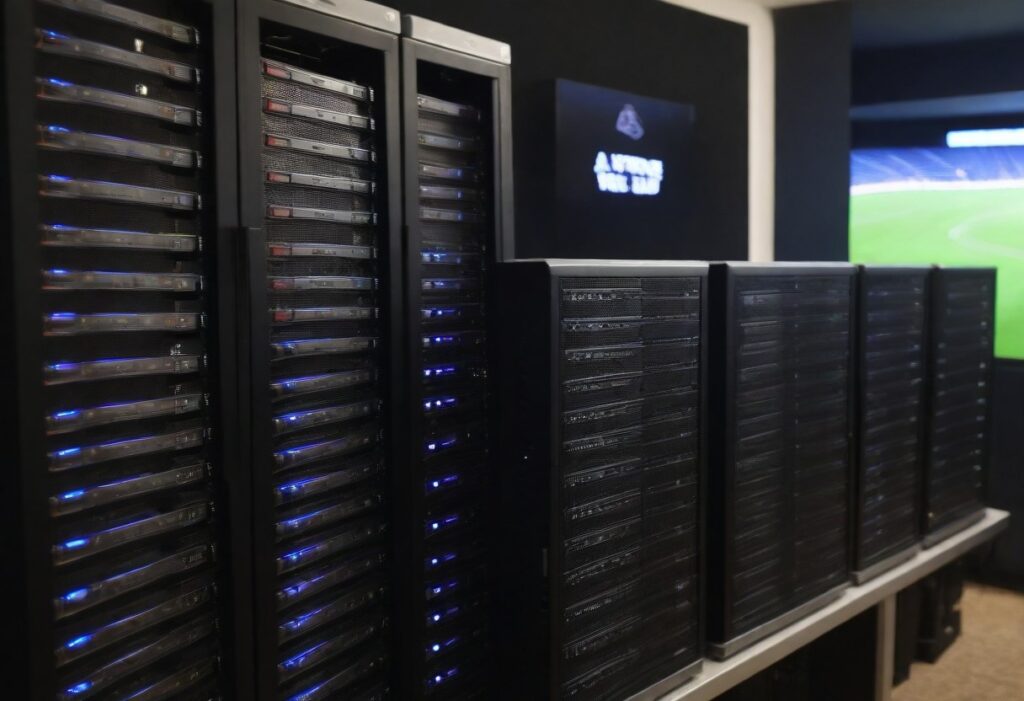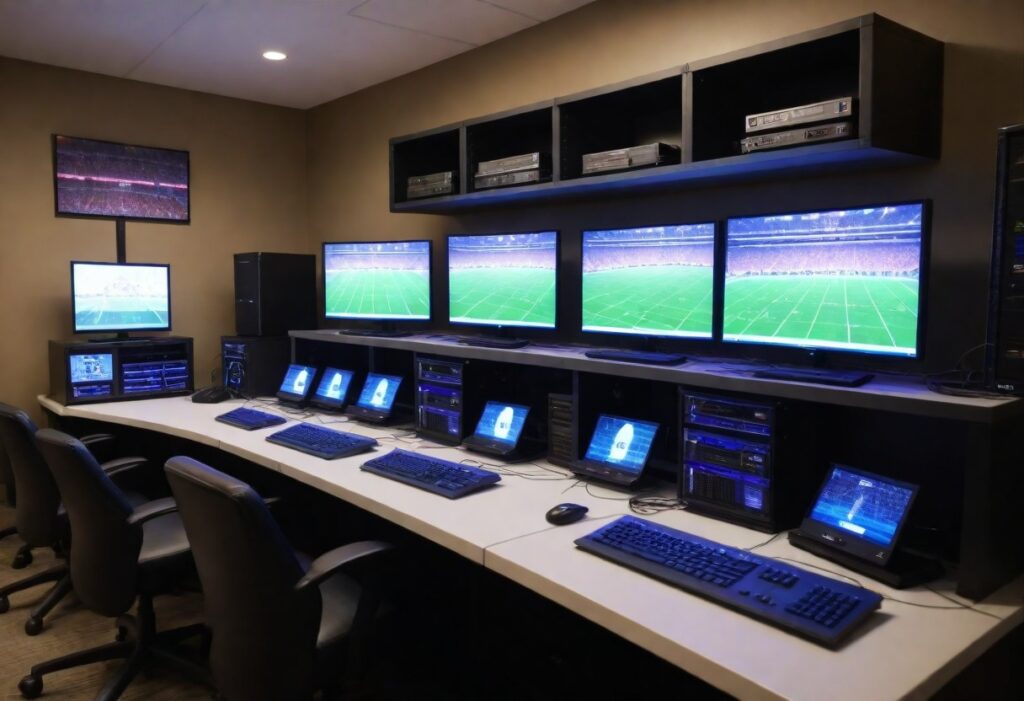Are you tired of constant buffering and poor quality while streaming? It’s time to take control of your online streaming experience by unleashing the power of dedicated streaming servers. With dedicated servers, you can optimize your streaming speed, quality, and reliability like never before.
Streaming servers are designed specifically for handling high-volume traffic and delivering content seamlessly to users. By choosing a dedicated streaming server, you can eliminate the hassles of shared resources and maximize the performance of your streaming platform. Whether you are a content creator, a live streamer, or a media company, dedicated streaming servers offer the scalability, flexibility, and control you need to deliver an exceptional streaming experience to your audience.
With a dedicated server, you can customize your streaming platform to meet your unique requirements. You’ll have the freedom to choose the hardware, software, and network settings that best suit your needs. Moreover, dedicated streaming servers minimize downtime and ensure that your content is always available to your viewers, improving user satisfaction and retention. Don’t let slow speeds and unreliable streaming ruin your online presence. Unlock the true potential of your streaming platform with dedicated streaming servers and provide your audience with the high-quality experience they deserve.
Benefits of using dedicated streaming servers.
Dedicated streaming servers offer a plethora of benefits that can significantly enhance your online streaming experience. Let’s explore some of the key advantages:
1. Unparalleled Performance:
Dedicated streaming servers provide unmatched performance compared to shared hosting. With dedicated resources at your disposal, you can ensure smooth streaming without interruptions or buffering issues. Your audience will enjoy a seamless streaming experience, resulting in higher viewer engagement and satisfaction.
2. Scalability and Flexibility:
Dedicated streaming servers offer the flexibility to scale your streaming platform as your audience grows. You can easily upgrade your server’s resources to accommodate increasing traffic and demand. This scalability ensures that your streaming service remains responsive and fast, even during peak usage periods.
3. Control and Customization:
With a dedicated streaming server, you have full control over your streaming platform. You can customize the server’s hardware, software, and network settings to meet your specific requirements. This level of control allows you to optimize your streaming performance, security, and user experience according to your preferences.
4. Enhanced Security:
Dedicated streaming servers provide enhanced security measures compared to shared hosting. Since you are the sole user of the server, there is a reduced risk of security breaches caused by other users. You can implement robust security protocols, such as firewalls, encryption, and access controls, to protect your streaming content and user data.
5. Reliability and Availability:
Dedicated streaming servers ensure high availability and minimal downtime. With dedicated resources, you won’t be affected by the performance issues or traffic spikes of other users. This reliability ensures that your streaming platform remains accessible to your audience at all times, building trust and loyalty among viewers.
6. Improved Analytics and Insights:
Dedicated streaming servers often come with advanced analytics and monitoring tools. These tools enable you to gather valuable insights about your audience, their viewing habits, and engagement metrics. By analyzing this data, you can make informed decisions to optimize your streaming content and improve the overall user experience. By leveraging these benefits, dedicated streaming servers empower you to deliver a superior streaming experience to your audience, helping you stand out in the competitive online streaming landscape.
Differences between dedicated streaming servers and shared hosting.
Shared hosting and dedicated streaming servers are two distinct hosting options with significant differences in performance, reliability, and control. Understanding these distinctions can help you make an informed decision when choosing the right hosting solution for your streaming platform.
1. Resource Allocation:
In shared hosting, multiple users share the same server resources, including CPU, RAM, and bandwidth. This sharing can lead to performance issues when one user consumes more resources, impacting the streaming experience for others. On the other hand, dedicated streaming servers provide exclusive resources solely dedicated to your streaming platform, ensuring consistent performance and eliminating the risks of resource contention.
2. Performance:
Shared hosting can suffer from performance bottlenecks when multiple users are simultaneously accessing the server. If one user experiences a sudden surge in traffic, it can affect the performance of other users sharing the same resources. Dedicated streaming servers, with their dedicated resources, deliver superior performance by eliminating the potential impact of other users on your streaming platform.
3. Customization and Control:
Shared hosting limits your ability to customize the server environment and software configurations. You are bound by the hosting provider’s predefined settings. In contrast, dedicated streaming servers offer complete control over the server’s hardware, software, and network settings. This flexibility allows you to tailor the server to meet your specific streaming requirements and optimize performance.
4. Security:
Shared hosting poses security risks as multiple users share the same server environment. If one user’s website or application is compromised, it can potentially affect the security of other users on the same server. Dedicated streaming servers mitigate this risk by providing isolated environments, reducing the chances of unauthorized access or data breaches.
5. Cost:
Shared hosting is generally more affordable than dedicated streaming servers since the costs are shared among multiple users. However, if you prioritize performance, control, and reliability, investing in a dedicated streaming server can provide a more cost-effective solution in the long run. Considering these differences, dedicated streaming servers emerge as the preferred choice for content creators, live streamers, and media companies who require optimal performance, customization, and security for their streaming platforms.
Choosing the right dedicated streaming server provider.
When choosing a dedicated streaming server provider, several factors should be considered to ensure a seamless streaming experience for your audience. Here are some key considerations to guide your decision-making process:
1. Reliability and Uptime Guarantee:
Look for a provider that offers a robust uptime guarantee, ensuring that your streaming platform remains accessible to your audience without significant downtime. Check for SLA (Service Level Agreement) commitments that outline the provider’s uptime guarantee.
2. Network Connectivity and Bandwidth:
Opt for a provider with high-speed, redundant network connectivity to ensure your streaming content reaches your viewers without latency or buffering issues. Adequate bandwidth allocation is crucial to handle the volume of traffic your streaming platform receives.
3. Server Hardware and Performance:
Evaluate the provider’s server hardware specifications, including CPU, RAM, and storage capacity. Ensure that the server’s performance aligns with your streaming requirements, especially if you expect high traffic and resource-intensive streaming.
4. Scalability Options:
Consider a provider that offers flexible scalability options, allowing you to upgrade your server’s resources as your streaming platform grows. Scalability ensures that your streaming service remains responsive and maintains high-quality streaming even during peak usage periods.
5. Technical Support and Expertise:
Assess the provider’s technical support capabilities and expertise. Look for providers with responsive customer support, available 24/7, to address any issues or concerns promptly. Additionally, providers with experience in streaming server management can offer valuable insights and guidance.
6. Security Measures:
Prioritize providers that implement robust security measures to protect your streaming content and user data. Features like firewalls, DDoS protection, and SSL certificates are essential to safeguard your streaming platform from potential threats.
7. Cost and Pricing Structure:
Compare the pricing structures of different providers to ensure they align with your budget and expected return on investment. Consider any additional costs, such as bandwidth overages or server management fees, to make an informed decision. By thoroughly evaluating these factors, you can select a dedicated streaming server provider that meets your specific needs and ensures a smooth and reliable streaming experience for your audience.
Setting up and configuring a dedicated streaming server.
Setting up and configuring a dedicated streaming server requires careful planning and execution. Follow these steps to ensure a successful setup:
1. Choose the Right Server Hardware:
Select a server with adequate CPU, RAM, and storage capacity to handle the demands of your streaming platform. Consider future growth and scalability when making your hardware choices.
2. Operating System and Software Installation:
Install the preferred operating system on your server, such as Linux or Windows Server. Set up essential software dependencies required for streaming, such as media servers like Wowza or nginx.
3. Network Configuration:
Configure the network settings of your server, including IP addresses, DNS, and firewall rules. Ensure proper connectivity and security measures to protect your server and streaming content.
4. Streaming Platform Configuration:
Set up your chosen streaming platform and configure the necessary settings, such as video codecs, bitrates, and resolutions. Customize the platform’s appearance and user interface to align with your branding.
5. Content Delivery Network (CDN) Integration:
Integrate a CDN into your streaming setup to enhance the delivery of your content to viewers across different geographical locations. CDN integration ensures high-speed streaming and reduces latency.
6. Testing and Optimization:
Perform extensive testing to ensure your streaming platform performs optimally. Test different scenarios, such as simultaneous user connections and varying streaming qualities, to identify and resolve any performance bottlenecks.
7. Backup and Disaster Recovery:
Implement a backup and disaster recovery strategy to protect your streaming content and server configurations. Regularly backup your data and set up mechanisms to quickly recover from any unexpected failures or data loss. By following these steps and paying attention to detail, you can set up and configure a dedicated streaming server that delivers top-notch performance and reliability to your audience.
Optimizing your streaming experience with dedicated servers.
Optimizing your streaming experience is crucial to provide your audience with a seamless and enjoyable viewing experience. Here are some optimization strategies to consider when using dedicated streaming servers:
1. Video Encoding and Bitrate:
Optimize your video encoding settings and adjust the bitrate according to your audience’s internet connection speeds. Provide multiple streaming quality options to accommodate viewers with varying bandwidth capabilities.
2. Caching and Content Delivery Network (CDN):
Leverage caching techniques and integrate a CDN into your streaming setup to reduce latency and improve content delivery. Caching frequently accessed content and distributing it across edge servers enhances the overall streaming performance.
3. Load Balancing and Scalability:
Implement load balancing to distribute traffic evenly across multiple streaming servers, ensuring optimal performance during peak usage periods. Scalability options, such as adding more servers or resources, help accommodate increasing traffic as your audience grows.
4. Compression and Transcoding:
Utilize compression and transcoding technologies to reduce the file size of your streaming content without sacrificing quality. This optimization technique reduces bandwidth requirements and improves streaming performance.
5. Buffering and Playback Optimization:
Fine-tune buffering settings to minimize buffering time and provide a smooth playback experience to your viewers. Optimize player settings and configurations to ensure compatibility across different devices and browsers.
6. Analytics and Monitoring:
Utilize analytics and monitoring tools to gather insights into your streaming performance and user engagement. Monitor key metrics, such as buffering rates, average bit-rate, and viewer drop-off points, to identify and address any potential issues promptly.
By implementing these optimization strategies, you can enhance your streaming platform’s performance, provide a superior viewing experience, and retain satisfied and engaged viewers.

Ensuring security and reliability with dedicated streaming servers.
Security and reliability are paramount when it comes to delivering a successful streaming experience. Here are some essential practices to ensure the security and reliability of your dedicated streaming servers:
1. Regular Updates and Patches:
Keep your server’s operating system, software, and applications up to date with the latest security patches. Regular updates help address vulnerabilities and protect your streaming platform from potential threats.
2. Firewall Configuration:
Configure a robust firewall to control incoming and outgoing network traffic. Restrict access to only essential ports and protocols, preventing unauthorized access and potential security breaches.
3. SSL Certificates:
Implement SSL certificates to secure the transmission of data between your streaming platform and viewers’ devices. SSL encryption safeguards sensitive information, such as login credentials and payment details.
4. Backup and Disaster Recovery:
Regularly back up your streaming content, server configurations, and databases to protect against data loss. Implement a disaster recovery plan to quickly restore your streaming platform in case of unexpected failures.
5. Access Controls and User Management:
Implement strict access controls and user management practices to prevent unauthorized access to your streaming server. Use strong passwords, enable two-factor authentication, and limit administrative access to trusted individuals.
6. Monitoring and Intrusion Detection:
Utilize monitoring and intrusion detection systems to identify and respond to potential security threats promptly. Monitor server logs, network traffic, and system performance to detect any unusual activity or vulnerabilities.
7. DDoS Protection:
Implement DDoS protection measures, such as rate limiting and traffic filtering, to mitigate the risk of distributed denial-of-service attacks. DDoS protection ensures uninterrupted streaming availability during potential attack scenarios.
By implementing robust security measures and following best practices, you can ensure the security and reliability of your dedicated streaming servers, protecting your streaming content and user data.
Monitoring and Troubleshooting Your Dedicated Streaming Server.
When it comes to managing a dedicated streaming server, monitoring and troubleshooting are essential to ensure optimal performance. Monitoring allows you to keep an eye on the server’s health, performance metrics, and potential issues that may affect your streaming experience. By proactively identifying and addressing these issues, you can prevent downtime and maintain a smooth streaming experience for your audience.
One crucial aspect of monitoring your dedicated streaming server is tracking bandwidth usage. Bandwidth is the amount of data that can be transmitted over your network connection within a given time frame. Monitoring your bandwidth usage helps you understand if you have enough capacity to handle your streaming traffic. If you notice that you’re consistently reaching the maximum bandwidth limit, it may be time to consider upgrading your server’s capacity or optimizing your streaming settings.
Another important metric to monitor is the server’s CPU and memory usage. The CPU is responsible for processing instructions and executing tasks, while memory stores data that the CPU needs to access quickly. High CPU or memory usage can indicate resource constraints, which may impact your streaming performance. By monitoring these metrics, you can identify potential bottlenecks and take appropriate actions, such as optimizing your streaming software or upgrading your hardware.
In addition to monitoring, troubleshooting is crucial for addressing any issues that arise with your dedicated streaming server. Common issues include network connectivity problems, software conflicts, or hardware failures. Having a troubleshooting plan in place can help you quickly identify the root cause of the problem and implement a solution. It’s important to document your troubleshooting steps and keep a log of any changes made to the server configuration. This documentation will prove invaluable if you encounter similar issues in the future or need to involve technical support. Monitoring and troubleshooting your dedicated streaming server require a proactive approach to ensure a seamless streaming experience for your audience. By regularly monitoring key metrics and promptly addressing any issues, you can optimize your server’s performance and deliver high-quality content to your viewers.
Future Trends in Dedicated Streaming Servers.
As technology continues to evolve, dedicated streaming servers are poised for exciting advancements. Here are some future trends that will shape the landscape of dedicated streaming servers:
1. Increased demand for 4K and beyond:
With the growing popularity of high-resolution content, dedicated streaming servers will need to handle the increased bandwidth requirements of 4K and even higher resolutions. Server providers will need to invest in robust infrastructure to support these demands and deliver a smooth streaming experience.
2. Edge computing:
Edge computing brings the processing power closer to the end-user, reducing latency and improving streaming performance. Dedicated streaming servers located at the edge of the network will enable faster content delivery, especially for live streaming events that require real-time interactions.
3. Artificial intelligence and machine learning:
AI and machine learning algorithms can enhance the streaming experience by analyzing user preferences and optimizing content delivery. Dedicated streaming servers will leverage these technologies to personalize recommendations, reduce buffering, and improve video quality based on each user’s viewing habits.
4. Enhanced security measures:
As streaming platforms handle sensitive user data and copyrighted content, security becomes a top priority. Future dedicated streaming servers will incorporate advanced encryption techniques, robust authentication mechanisms, and proactive threat detection to protect user privacy and prevent unauthorized access.
5. Integration with virtual and augmented reality:
Virtual and augmented reality technologies are gaining traction in the streaming industry. Dedicated streaming servers will play a crucial role in delivering immersive VR and AR experiences by providing low-latency, high-bandwidth connections required for real-time rendering and streaming of 3D content.
The future of dedicated streaming servers is promising and will revolutionize the way we consume and deliver online content. By staying ahead of these trends and embracing new technologies, streaming platforms can provide their audience with an unparalleled streaming experience.
Conclusion:
Dedicated streaming servers offer a multitude of benefits for content creators, live streamers, and media companies. By choosing a dedicated server, you can optimize your streaming speed, quality, and reliability. With the ability to customize your streaming platform and minimize downtime, you can deliver an exceptional streaming experience to your audience.
Monitoring and troubleshooting your dedicated streaming server are essential for maintaining optimal performance. By tracking important metrics, such as bandwidth usage, CPU, and memory usage, you can proactively address any issues that may impact your streaming experience. Having a troubleshooting plan in place will help you quickly identify and resolve problems, ensuring minimal downtime and a smooth streaming experience for your viewers.
Looking ahead, future trends in dedicated streaming servers, such as increased demand for higher resolutions, edge computing, AI and machine learning integration, enhanced security measures, and virtual and augmented reality, will shape the future of streaming. Embracing these trends will allow streaming platforms to deliver immersive, personalized, and secure streaming experiences. Don’t settle for subpar streaming performance. Unleash the power of dedicated streaming servers and optimize your online streaming experience like never before. Your audience deserves the best, and with dedicated servers, you can provide them with the high-quality content they crave.

